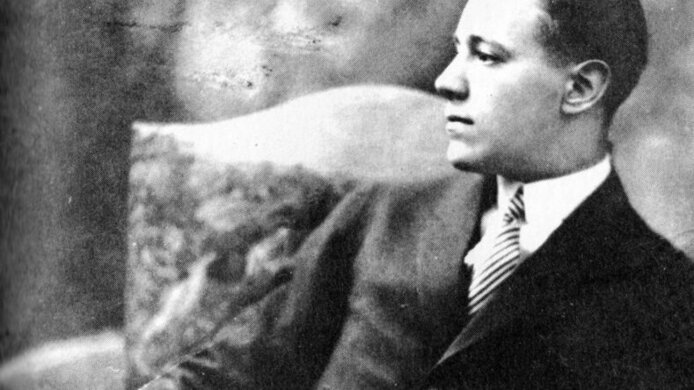Ödön von Horváth: highly modern and quite ambivalent

Fate did not grant much time to one of the most important representatives of modernist literature. At the age of just 37, as is well-known, Ödön von Horváth met his premature death. In Parisian exile, on his way to America, the young writer was struck by a falling tree branch which injured him fatally. Only a few years earlier (1931/32) Horváth had been living in Berlin and was on the brink of becoming one of the great theatre luminaries of the Weimar Republic. The advent of the Nazis, however, thwarted his career, and his plays were no longer staged. “But Horváth did actually seek a working relationship with the regime during this period,” reports Klaus Kastberger. Among other things, Horváth tried to work for the film industry and paid homage to the regime in Berlin, as is evidenced by several documents. “It has to be noted that Horváth researchers are reluctant to acknowledge this fact,” says Kastberger, a literary scholar at the University of Graz. With the support of the Austrian Science Fund FWF, Kastberger and his team have spent several years examining Horváth’s work. The resulting Wiener Ausgabe Ödön von Horváths is a critical historical edition comprising a total of 19 volumes. Work is still in progress on four complex volumes, including a volume of letters and documents and a handbook summarizing the state of research.
Acting out ambivalent attitudes
Kastberger finds Ödon von Horváth to have been likely a more ambivalent writer and person than is generally realized, but he does not see that as speaking against the author. “There is a strong tendency in Horváth's work to mask his figures. With him, everything is a mask, even language.” In this way the writer managed to capture the mood of a time when society was visibly disintegrating. Everything culminated, or so it seemed, in a veritable play of masks and disguises. According to Kastberger, Horváth himself was also inclined to wear masks, which resulted in a contradictory personality and reveals snapshot-like sides of him no longer apparent in later phases of his life.
Horváth still present today
Being able to trace the genesis of Horváth's entire oeuvre for the first time also provides the answer to the question as to why Horváth is still so enormously present in the theatre and the classroom today. Apart from recurring themes such as unemployment, refugee movements or political changes, Kastberger sees above all a formal reason for the author's timeless validity: “The fact that Horváth crafts something from such themes that still holds true 100 years later is due exclusively to his detailed work on language, to which he devoted an incredible amount of energy," says the German Studies scholar. “He managed successfully to present issues in a way that both resonated with the respective period and opens them up for other contexts.”
Ultra-modern writing processes
Horváth’s oeuvre, which has not lost any of its cogency, is based on complex writing processes, another aspect that becomes very clear in this new edition. Armed with paste and scissors, Horváth used editing and montage techniques that enabled him to mix and remix texts repeatedly and keep developing them – a working style that put the writer fully into modernism. “In our edition we have tried to illustrate this difficult process by means of so-called simulation graphics that show how the material migrated over time. An innovative editing technology enabled us to do this,” notes Kastberger in explaining the production process underlying the edition. As a result, the volumes – each of which involved one and a half to two years of work – allow deep insights for the first time into the world of Ödön von Horváth’s writing and life.
High visibility
This means the edition not only provides a solid textual basis for research, but can also be used for work in the theatre. Many directors, including famous names such as Frank Castorf, now use the critical historical edition as the basis for theatre productions. Incidentally, work is also underway on a digital edition. At the moment it features Geschichten aus dem Wiener Wald and offers additional possibilities for exploring Horváth's works. Principal investigator Kastberger is particularly pleased that the critical historical edition has aroused interest beyond the world of science. In addition to use in the theatre and in classrooms, his research has also been highlighted at a successful exhibition: after Munich and Vienna, Horváth und das Theater can be seen at the Literaturhaus Graz as from 9 January 2020.
Personal details
Klaus Kastberger assumed the positions of Professor of Modern German Literature at the Franz Nabl Institute, University of Graz, and of Director of the Literaturhaus Graz in 2015. He is also member of the Ingeborg Bachmann prize jury. With the support of the FWF, the German Studies scholar has published the critical historical edition of Ödön von Horváth through de Gruyter, released by Reclam as a readers’ edition; he has also set up an online research platform on the work of Peter Handke at the Austrian National Library. In the course of the Nobel Prize award to Peter Handke, handkeonline.onb.ac.at recorded more than 10,000 hits per month.
Publication
Ödön von Horváth: Wiener Ausgabe sämtlicher Werke. Historisch-kritische Edition. Am Literaturarchiv der Österreichischen Nationalbibliothek und am Franz-Nabl-Institut für Literaturforschung der Karl-Franzens-Universität Graz. Hg. v. Klaus Kastberger. Berlin: de Gruyter 2009ff.





